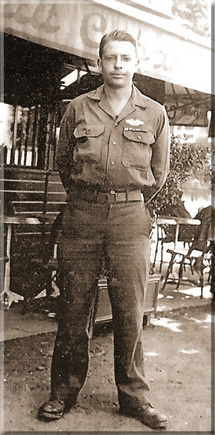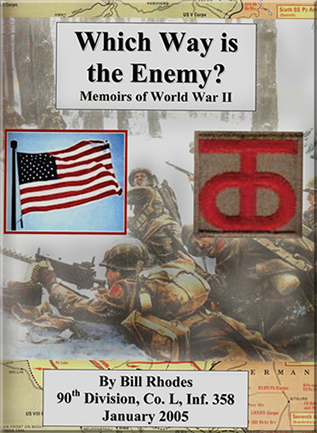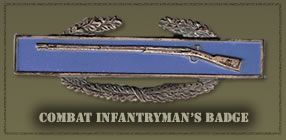
Bill Rhodes — L Company, third battalion, 358th Infantry Regiment, 90th Division
Which Way is the Enemy?
Memoirs of World War II
By Bill Rhodes
While combat soldiers have many similar experiences, each soldier has his own unique experiences of the war, his own individual story to tell, and this is my story, exactly as I remember it. Which Way is the Enemy?
One day, while serving in Normandy, I was a confused replacement trying to adjust to the shock of warfare and I said to my Sergeant. “Sergeant, I have just one question. Which way is the Enemy?”
His answer was “Don’t ask so many damn fool questions!” He was no doubt as frustrated with the war as I was.
Later I learned from experience that you can never be absolutely sure where the enemy is and from which direction he will attack you.
Most combat soldiers are killed or wounded by artillery or mortar shells fired by an unseen enemy. But for the rest of the war that question was always on my mind, and it might be a relevant question even in today’s world. “Which way is the Enemy?”
This book would not be possible except for the long hours of typing done by my daughter. She is truly my co-author. We dedicate this book to all the veterans of the 90th Division who fought in World War II.
 My War Began
My War Began
My war began about a week after D-Day, June 1944. We were put on a ship and sailed for Utah Beach in Normandy. We climbed down the side of the ship on rope ladders, holding our rifles with a full pack on our backs. I was able to step out of the assault boat onto dry land, thanks to those who had gone before us.
After landing we dropped our packs, never to see them again. We were assigned to the 90th Division as replacements. I went to L Company. I got my last full night’s sleep for many nights to come.
The next day we started walking, single file up a road to the Frontline. As we walked, we came to some soldiers from Graves Registration sitting by the bodies of six soldiers — three Americans and three Germans. One soldier asked me, “How does it feel to be going up where the action is, on the front line?” I looked at the bodies again and thought, “You’re lucky to have a safe job back here.” Seeing the bodies was part of the shock of war as you realized you are in a war and your life could soon end. For some reason I had never thought that I would be afraid when I got into combat, but now I had to live with fear. Fortunately, I found a new resource that I didn’t know I had. Prayer. For the first few weeks I kept my fear to myself because none of the other soldiers looked like they were afraid, but after a few weeks of battles, we began to share our fears and even try to joke about them.
 Gradually we adjusted to combat, adopted a fatalistic attitude (“what will be will be!”) and began to take pride in our battle skills. We took pride in wearing our Combat Infantry Badges, which we earned and received after at least 30 days of combat. Hand grenades became our favorite weapon along with our M1 Rifle. Bodies no longer shocked us. We all carried German Pistols as fast as we could get them, and we lived the war one day at a time. We were content to eat K-rations day after day. We shared with our buddies. If we had a stick of gum, we would break it in two and give half to our buddy. At night we would stay awake and guard while the other soldier slept, until it was his turn. We had no idea what was ahead of us when we landed on Utah Beach!
Gradually we adjusted to combat, adopted a fatalistic attitude (“what will be will be!”) and began to take pride in our battle skills. We took pride in wearing our Combat Infantry Badges, which we earned and received after at least 30 days of combat. Hand grenades became our favorite weapon along with our M1 Rifle. Bodies no longer shocked us. We all carried German Pistols as fast as we could get them, and we lived the war one day at a time. We were content to eat K-rations day after day. We shared with our buddies. If we had a stick of gum, we would break it in two and give half to our buddy. At night we would stay awake and guard while the other soldier slept, until it was his turn. We had no idea what was ahead of us when we landed on Utah Beach!
Bill Rhodes >> Story 01 | Story 02 | Story 03 | Story 04 | Story 05 | Photos | Photos 2
